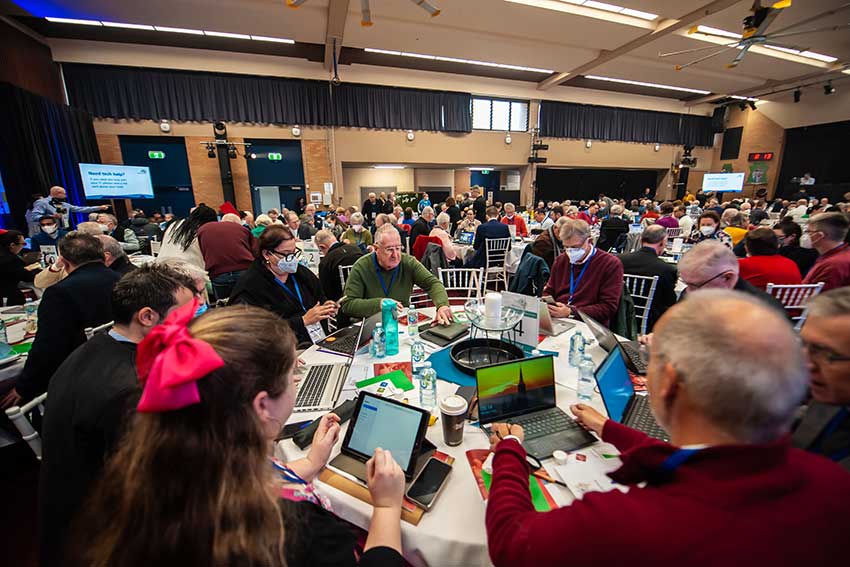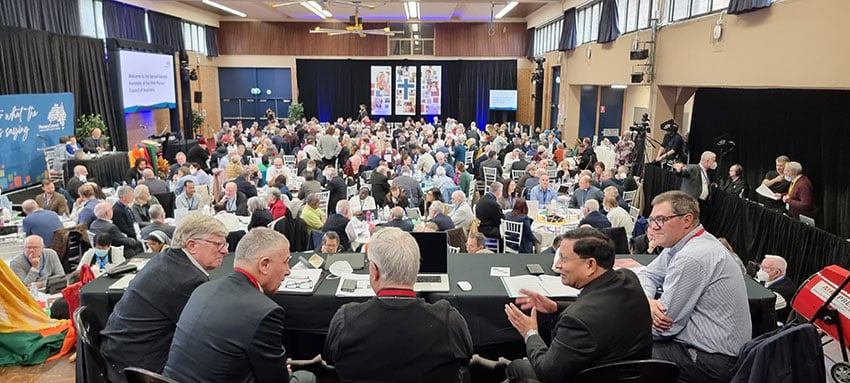
The opening days of the fifth Plenary Council have surfaced the complex realities and fissures that underlie the Church in Australia. They have given clear light to the breadth of the Church’s presence to the faithful and in society and the abiding wounds within the Church. The days have also, and predictably, exposed deep differences in conceptions of the Church and the ways in which we form or shape the Church by our participation in it.
It is important to acknowledge that some of the tensions that have arisen among the members of the Council – evident today in relation to motions that address the role and dignity of women within the Church[1] – have in no small part been the result of a Plenary Council process that has made scant provision for adaptation and nuance in its proceedings.
One motion – but numerous issues
For example, in that section of contention in the members’ guiding document related to “witnessing to the equal dignity of women and men” a single motion embraces a whole range of issues, from women’s remuneration, prospective access to the ministry of deacon, types of formation and expressions of leadership, to listening forums with bishops, each with their own specific details for consideration but which members are forced to accept or reject as a group, that is in toto without capacity for differentiation amongst them.
In response the Steering Committee appointed to the Council, with the support of most members, is now seeking to address this limitation in the Council’s process. It is an important development for this shortcoming was evident from the opening motion voted upon at the Council, a motion which failed to pass with a qualified majority – not on account of a widespread rejection of the substance of its content but due to the inflexibility of the Council process to absorb the real-time feedback of members, including those with a deliberative vote (in this case, to amend paragraphs that failed to recognise the distinctive features of the Eastern churches, in spirituality and canon law among others).

A divergence in thinking about the Church
However, the tensions within the Council are not only the result of issues with the process of the Council itself but also by the distinct ecclesiological imaginations at play among members. This divergence is most evident in language with at least two primary dialects evident on the Council floor, two forms of expression which reveal distinct understandings of what the Church is and our relationship to that Church.
I contend that one dialect evidences a focus largely on the outward organisation or ‘form’ of the Church and the re-distribution of its goods. The other sets its focus upon the inner life of faith, on the common need for conversion and the call to evangelisation, elements which Pope Francis would uphold give substance to and ought to animate the Church’s life and mission in the world.
Constructing the Church anew?
As an instance of the first register, we have seen the proposal and then support for new forums to complement already existing structures, namely the National Catholic Education Commission; for new triennial national forums across Church agencies, with other rearrangements and institutional modifications to be discussed in the days ahead. Amongst these is a not-too-subtle advancement of public juridic persons as a “third” player in the governance of the Church, alongside the bishops and religious of Australia. Underlying such proposals is almost an ethic of ‘constructing’ the Church anew, a model of Church renewal by mere addition.
In this setting the more interior and evangelical language of ‘conversion’ and ‘discipleship’ struggles for oxygen, despite the diagnosis of a crisis of faith and practice in Australia as evidenced in the latest Census figures and apparent to anyone who has darkened the door of their local parish over the past six decades.
“In this setting the more interior and evangelical language of ‘conversion’ and ‘discipleship’ struggles for oxygen, despite the diagnosis of a crisis of faith and practice in Australia …”
Mission drift
So, from observation, the disjunction between these two ecclesial perspectives is clear at this Council. It leaves some members promoting ecclesial priorities which others struggle to see or appreciate with any enthusiasm.
Tellingly the consequence of this disjunction in ecclesial perspective – of ‘structure’ and ‘spirit’ – is becoming more evident in our Australian context. One of the traditional strengths of the Church in this country, its sizeable institutional footprint in areas of social support, health and education, could well become a real impediment for the evangelising mission of the Church in its future if the workforce including the CEOs and leaders of these ecclesial structures do not evince a clear and explicit commitment to the Catholic faith, not only its ‘ethos’ but its morals, worship and understanding of the human person.
The path to disintegration
History has shown us that when the organisation and practical actions of ecclesial bodies lose contact with the Catholic tradition, its teachings and sacramental life, they not only diminish but ultimately disintegrate.
In the days ahead, I pray the members of the Council can ground the many practical concerns being discerned for the Church in Australia in the primacy of a living faith, that they can increasingly speak the ‘dialect’ of conversion and evangelisation upon which the house of God depends for its vitality and life.
[1] Section 4 of the guiding “Motions and Amendments” document.
Related
